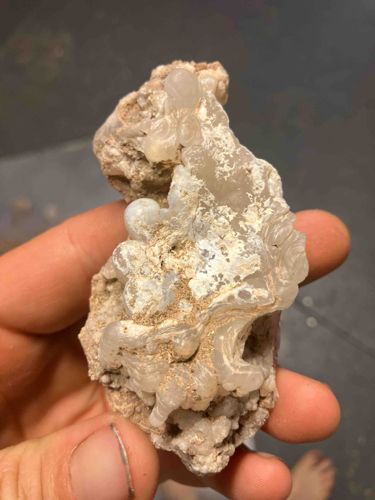
Botryoidal Chalcedony or Opal in Matrix Specimen
This item is a raw mineral specimen, likely a form of chalcedony or opal, exhibiting botryoidal and stalactitic formations within a rocky matrix. The overall size is small enough to be comfortably held in one hand, suggesting dimensions of approximately 3 to 5 inches in its longest dimension. The main mineral growth is translucent to milky white, with some areas appearing more opaque due to inclusions or denser formation. There are distinct bulbous, grape-like structures (botryoidal habit) varying in size from small beads to larger, more elongated stalactite-like shapes. These formations display subtle concentric banding or growth rings, particularly visible in the more translucent sections, indicating a layered deposition process. The mineral is embedded in a light brown to tan natural rock matrix, which has a rough, somewhat crumbly texture, possibly sandstone or a similar sedimentary rock. Specks of what appears to be fine sand or dirt are visible clinging to the rough surfaces of both the mineral growth and the matrix. The overall condition appears to be natural and unpolished, showing no signs of artificial manipulation, cutting, or polishing. There are no apparent major chips or breaks that would indicate damage since its extraction, suggesting it is in its natural state. The quality of the crystal formation, with its well-defined botryoidal globes and delicate stalactitic fingers, is good, making it a desirable specimen for collectors of natural minerals. The lack of any discernible manufacturing marks, signatures, or stamps confirms its natural origin. Based on its characteristics, it is a geological specimen, likely a product of hydrothermal or sedimentary processes over a significant geological time period.
AI-Generated Appraisal Disclaimer
Estimated Value
$150-250
Basic Information
Category
Mineral Specimen
Appraised On
November 29, 2025
Estimated Value
$150-250
Item Description
This item is a raw mineral specimen, likely a form of chalcedony or opal, exhibiting botryoidal and stalactitic formations within a rocky matrix. The overall size is small enough to be comfortably held in one hand, suggesting dimensions of approximately 3 to 5 inches in its longest dimension. The main mineral growth is translucent to milky white, with some areas appearing more opaque due to inclusions or denser formation. There are distinct bulbous, grape-like structures (botryoidal habit) varying in size from small beads to larger, more elongated stalactite-like shapes. These formations display subtle concentric banding or growth rings, particularly visible in the more translucent sections, indicating a layered deposition process. The mineral is embedded in a light brown to tan natural rock matrix, which has a rough, somewhat crumbly texture, possibly sandstone or a similar sedimentary rock. Specks of what appears to be fine sand or dirt are visible clinging to the rough surfaces of both the mineral growth and the matrix. The overall condition appears to be natural and unpolished, showing no signs of artificial manipulation, cutting, or polishing. There are no apparent major chips or breaks that would indicate damage since its extraction, suggesting it is in its natural state. The quality of the crystal formation, with its well-defined botryoidal globes and delicate stalactitic fingers, is good, making it a desirable specimen for collectors of natural minerals. The lack of any discernible manufacturing marks, signatures, or stamps confirms its natural origin. Based on its characteristics, it is a geological specimen, likely a product of hydrothermal or sedimentary processes over a significant geological time period.
Get Your Items Appraised
Instant estimates of your treasures with AI-powered instant appraisals